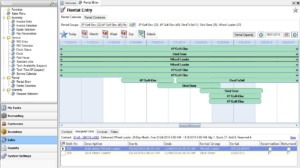Track the lifespan of a rental unit from cradle to grave.
View rental contracts, check rental capacity and track lost sales from the ASPEN Rental Calendar screen.
ASPEN’s robust financial utilization reporting helps you decide when to expand or transfer units out of the rental fleet and more timely decisions. Whether opting for scheduled depreciation, on-demand depreciation, or depreciation as a percentage of rental income, ASPEN monitors that cost basis never goes below the designated salvage value—so you can stay on top of unit depreciation.
- Find Units records quickly with ASPEN’s powerful Unit Selection screen by searching on any field. Easily view and sort, or further refine the resulting records by applying filters in an easy-to-view and sort grid. View mode allows editing of those records without having to search again. As with all ASPEN selection screens, results are exportable.
- View/edit unit quickly or drill down to view/edit base information, serial numbers, options, comments, notes and any related transactions. Unit location transfers, category changes, and cost adjustment create a Journal Entry in the General Ledger, keeping the subsidiary ledger in balance with the General Ledger.
-
Quickly and easily add multiple units sharing the same configuration with streamlined processes for adding inventory. The “Add Multiple” box eliminates the need to add specs to each record individually, templates of equipment profiles can be set for each model sold., and creating groups of unit types simplifies searches.
-
Easily access customer and in-stock units from the same screen. Customer units can also be viewed through the customer record with just a mouse click.
-
Transfer units between locations with a few mouse clicks and automatically create a Journal Entry.
-
View associated Accounts Payable vouchers with one mouse click.
-
Advanced users can apply a mass update to a specific field in a selected group of records, such as a change to a model description, make, unit group, user-defined fields, retail minimum margin and rental group. For example, specify a minimum margin to selected records.
- Maintain accurate cost on units and proper margins at sale: point of sale internal tickets and costs entered through Accounts Payable and cost adjustments update unit cost. Rental depreciation updates rental cost until salvage value is reached. Unit cost adjustments can also impact retail and will create a transaction and audit trail.
- Add to customer service by selecting which options and comments from the unit record you wish to show on a customer invoice.
- A reminder date option such as “last date to sell” can help push sales or indicate when interest begins to accrue, etc. for each unit.
-
Unit condition such as “Used-Good Condition” etc. simplifies locating a unit.
-
Associate related attachments with the base unit record to assist with inventory, locating an attachment and maintaining a total retail price of the unit and attachment. Access the attachment record from the unit record and vice-versa. Attachment retains its own history even if moved to another unit record or removed at point of sale.
-
Keep all information relating to the unit on record: Attach files such as pictures, original invoices, shipping documents, to the unit record.
